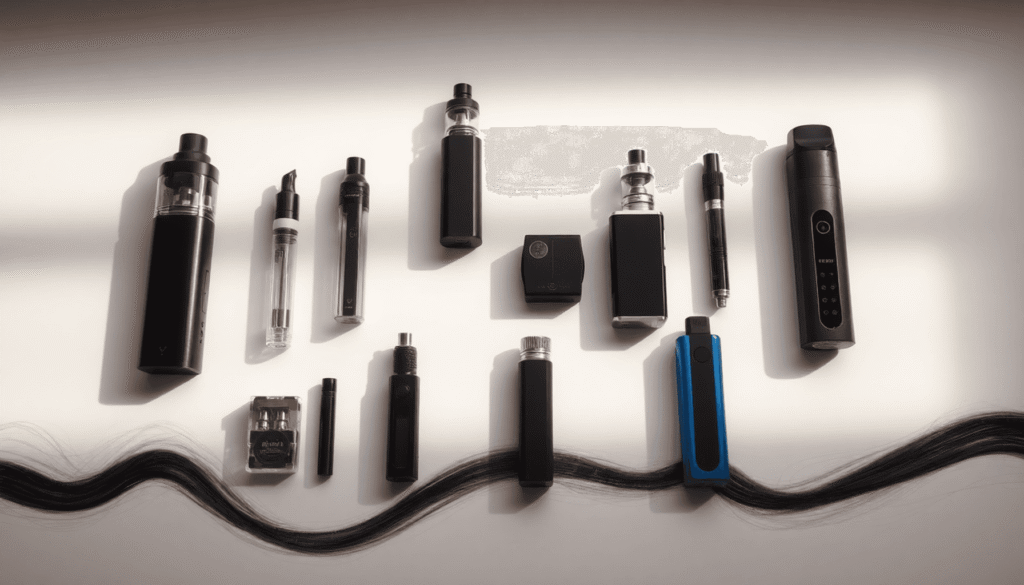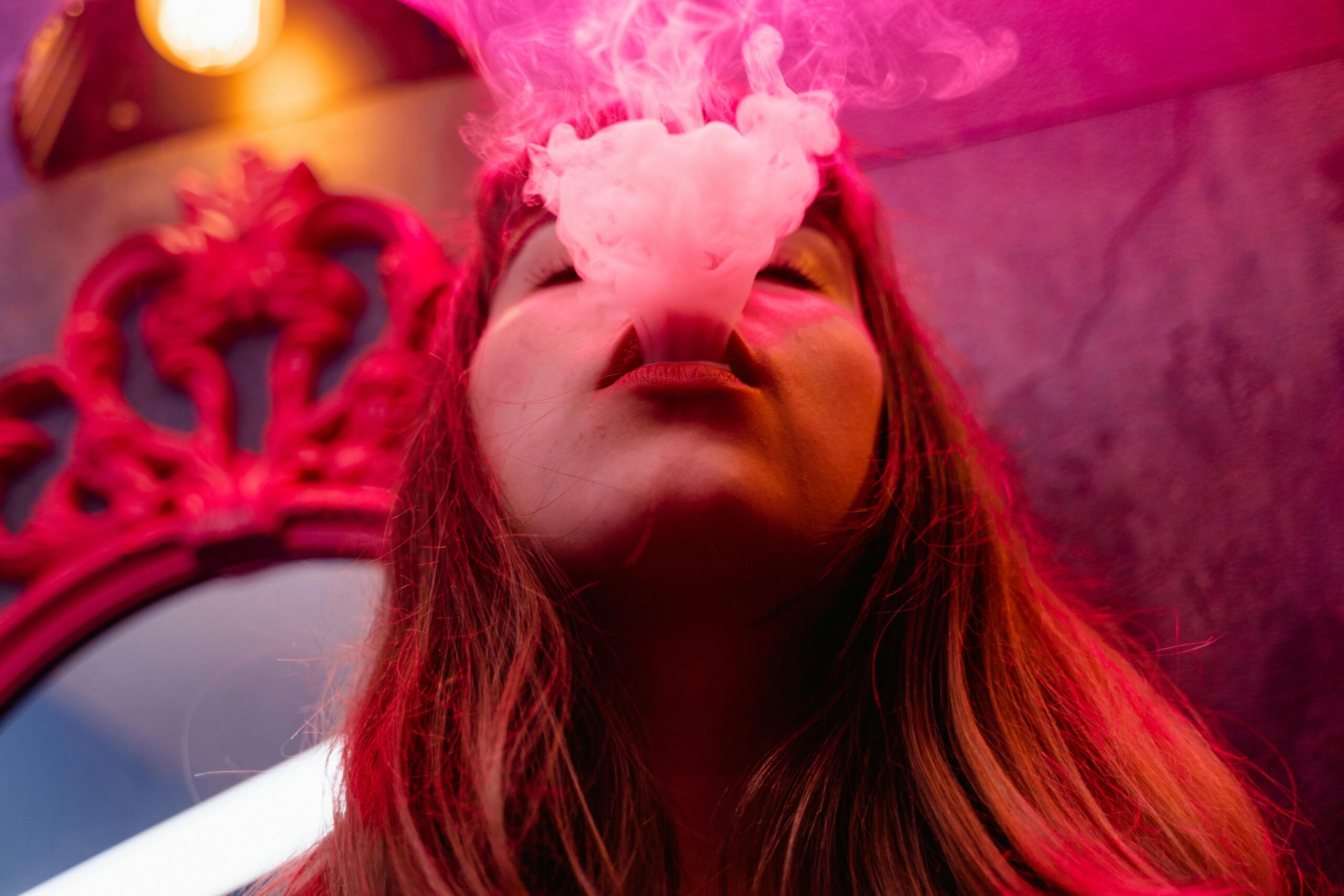Vaping has become extremely popular, especially among young adults looking for an alternative to traditional smoking. With stylish devices and appealing flavour choices, the UK has seen a significant increase in vape users, with an estimated 4.3 million people using them in 2022.
However, with this growing trend, a concerning question has come up: Can vaping cause hair loss? This question has sparked discussions on social media and health forums, with users sharing personal stories of unexpected hair thinning after starting to vape.
The connection between vaping and hair health needs to be carefully examined. While there isn’t much research directly linking vaping to hair loss, emerging studies suggest potential connections through various biological processes. Understanding these effects is crucial for:
- Making informed decisions about vaping habits
- Recognising early warning signs of hair-related issues
- Taking preventive measures to protect hair health
As vaping technology evolves and usage patterns change, staying informed about its potential impact on our bodies – including our hair – becomes increasingly important for both current vapers and those considering taking up the habit.
Understanding Vaping Devices and Their Components
The vaping market offers diverse device options, each with unique features and functionalities. Here’s a breakdown of the main types:
1. Pod Systems
- Compact, portable devices
- Pre-filled or refillable pods
- Ideal for beginners
- Limited customisation options
- Battery capacity: 200-800mAh
2. Vape Pens
- Pen-shaped devices
- Larger than pod systems
- Refillable tanks
- Adjustable settings
- Battery capacity: 650-1500mAh
3. Box Mods
- Advanced devices
- Multiple power settings
- Customisable features
- Larger size
- Battery capacity: 1500-4000mAh
E-liquids, the substance heated in these devices, contain:
- Propylene Glycol (PG)
- Vegetable Glycerin (VG)
- Nicotine (0-20mg/ml in UK)
- Flavourings
The nicotine content in e-liquids plays a crucial role in potential hair-related issues. Research published in the Journal of Dermatology indicates that nicotine causes vasoconstriction – the narrowing of blood vessels. This reduction in blood flow can affect hair follicles by:
- Limiting oxygen supply
- Reducing nutrient delivery
- Decreasing growth factors
- Impacting cellular regeneration
Studies from the British Journal of Dermatology suggest that reduced blood flow to hair follicles can lead to:
- Weakened hair strands
- Slower hair growth
- Increased hair shedding
- Potential follicle damage
The concentration of nicotine in vaping devices directly influences these effects, with higher levels potentially causing more significant impact on blood vessel constriction.
The Role of Chemicals in Vape Liquids
Vape liquids contain a complex mixture of chemicals that can affect hair health in unexpected ways. Research has identified several concerning compounds:
- Formaldehyde: This known carcinogen forms when e-liquid is heated at high temperatures. Studies suggest it can damage protein structures in hair follicles, potentially weakening hair strands.
- Acrolein: A toxic chemical created during the heating process that can cause cellular damage and oxidative stress to hair follicles.
- Propylene Glycol (PG) and Vegetable Glycerin (VG): While considered safe for consumption, these base ingredients can cause dehydration, potentially leading to dry, brittle hair.
The impact of toxic exposure through prolonged vaping manifests in several ways:
- Direct contact with vape clouds can deposit chemicals onto the scalp
- Systemic absorption through lungs affects blood circulation to hair follicles
- Accumulation of toxins may disrupt normal hair growth cycles
Artificial flavourings in e-liquids present additional risks. These compounds can trigger:
- Localised inflammation around hair follicles
- Allergic reactions affecting scalp health
- Disruption of natural oil production
Research from the Journal of Toxicology Studies indicates that certain flavour compounds, particularly sweet and fruity varieties, may cause more significant inflammatory responses. This inflammation can constrict hair follicles, potentially accelerating hair thinning and loss.
The chemical cocktail in vape liquids doesn’t just affect visible hair – it impacts the entire follicular structure. Scientists have observed changes in:
- Follicle stem cell function
- Protein synthesis necessary for hair growth
- Natural regeneration cycles of hair follicles
How Vaping May Contribute to Hair Loss: A Closer Look at the Mechanisms Involved
The relationship between vaping and hair loss involves three primary mechanisms: reduced blood circulation, direct chemical exposure and hormonal disruption.
Nicotine’s Effect on Blood Flow
Nicotine acts as a vasoconstrictor, causing blood vessels to narrow. This restriction:
- Reduces oxygen delivery to hair follicles
- Limits essential nutrient supply
- Decreases growth-promoting compounds reaching the scalp
Research indicates that hair follicles deprived of proper blood flow can enter a dormant phase, leading to increased shedding and slower regrowth rates.
Direct Chemical Impact on Hair Structure
The vapour produced by e-cigarettes creates a direct pathway for harmful substances to interact with hair follicles:
- Oxidative Stress: Free radicals damage cellular structures within follicles
- Protein Degradation: Chemical exposure weakens hair shaft proteins
- Cellular Death: Prolonged exposure can trigger premature follicle cell death
Hormonal Disruption
Regular nicotine consumption through vaping can alter hormone levels in significant ways:
- Increased cortisol production (stress hormone)
- Disrupted androgen balance
- Altered thyroid function
These hormonal changes can trigger or worsen pattern hair loss, particularly in individuals with genetic predisposition to hair thinning.
The Compounding Effect
When these three mechanisms work together, they create a challenging environment for healthy hair growth:
- Weakened follicles receive less nutrition
- Damaged cellular structures struggle to maintain normal function
- Hormonal imbalances interfere with natural growth cycles
Recent studies suggest that younger vapers might face higher risks due to their developing endocrine systems and more frequent vaping habits. Moreover, the combination of vaping and its associated health risks could further exacerbate the issue of hair loss.
The Impact of Quitting Vaping on Hair Health: What We Know So Far
Former vapers report significant improvements in their hair health after quitting. Many users share experiences of:
- Increased hair thickness within 3-6 months
- Reduced hair shedding during washing and brushing
- Improved hair texture and shine
- Better scalp health with less irritation
These positive changes stem from restored blood circulation to hair follicles once nicotine exposure stops. The body begins healing itself, allowing proper nutrient delivery to the scalp and hair roots.
The Initial Withdrawal Phase
The journey isn’t always smooth sailing. Some ex-vapers experience temporary hair shedding during the first few weeks after quitting. This phenomenon, known as telogen effluvium, occurs when the body undergoes significant stress or changes. Common symptoms include:
- Increased hair fall for 2-4 weeks
- Noticeable thinning around the crown
- Scalp tenderness or sensitivity
This temporary shedding typically resolves on its own as the body adjusts to life without nicotine. Users who stick with their decision to quit often notice their hair entering a healthier growth cycle by the 3-month mark.
Recovery Timeline
While individual experiences vary, a typical hair recovery pattern after quitting vaping looks like this:
- Weeks 1-4: Possible increased shedding
- Months 1-2: Stabilisation of hair loss
- Months 3-6: New hair growth becomes visible
- Months 6+: Continued improvement in hair thickness and health
Supporting evidence comes primarily from user testimonials across vaping cessation forums and support groups, as formal research specifically tracking hair recovery post-vaping remains limited.
Other Factors That Can Influence Hair Loss Beyond Vaping Alone
Hair loss rarely stems from a single cause. While vaping might play a role, several other significant factors can contribute to thinning hair:
1. Genetic Predisposition
- Androgenetic alopecia affects up to 50% of men by age 50
- DHT sensitivity in hair follicles leads to progressive miniaturisation
- Family history on either parent’s side can indicate likelihood of hair loss
- Women with genetic predisposition often experience diffuse thinning
2. Stress-Related Hair Loss
- Telogen effluvium triggers excessive shedding during high-stress periods
- Physical stress from illness, surgery or dramatic weight loss
- Emotional stress activates stress hormones affecting hair growth cycles
- Sleep deprivation impacts cellular repair and hormone balance
3. Nutritional Impact
- Iron deficiency affects hair follicle function and growth
- Insufficient protein intake weakens hair structure
- Vitamin D deficiency linked to hair thinning and loss
- Zinc and biotin play crucial roles in maintaining healthy hair
These factors can work independently or combine with vaping habits to accelerate hair loss. A blood test from your GP can identify nutritional deficiencies, while a dermatologist can assess genetic patterns and stress-related hair loss symptoms.
Conclusion
The question “can vaping cause hair loss?” remains partially unanswered due to limited scientific research. While existing studies suggest potential links between vaping and hair health issues, substantial gaps exist in our understanding of the long-term impacts.
Research teams need to conduct extensive clinical trials to:
- Examine the direct effects of e-cigarette vapour on hair follicles
- Study the relationship between nicotine absorption through vaping and hair loss patterns
- Track long-term hair health outcomes in regular vapers
Until definitive research emerges, individuals experiencing hair loss who vape should consider taking proactive steps to protect their hair health. These might include:
- Reducing vaping frequency or quitting completely
- Choosing e-liquids with lower nicotine content
- Consulting healthcare professionals about hair loss concerns
The safest approach remains cautious – if you value your hair health, limiting or eliminating vaping could be a wise preventive measure. Your hair’s wellbeing might just thank you for making this choice.
FAQs
Can vaping cause hair loss?
Vaping may contribute to hair loss due to nicotine-induced vasoconstriction reducing blood circulation to hair follicles, exposure to harmful chemicals in vape liquids and potential hormonal changes caused by regular nicotine intake.
What harmful chemicals in vape liquids can affect hair health?
Vape liquids often contain toxic chemicals such as formaldehyde and acrolein, which can damage hair follicles through prolonged exposure. Additionally, flavourings in e-liquids may cause inflammation around hair follicles, contributing to hair loss.
How does nicotine in vaping products impact hair follicles?
Nicotine causes vasoconstriction, narrowing blood vessels which reduces blood flow to hair follicles. This decreased circulation can impair follicle function and lead to potential hair thinning or loss over time.
Does quitting vaping improve hair regrowth?
Quitting vaping may promote healthier hair regrowth based on anecdotal evidence from former vapers. However, some individuals might experience temporary increased hair shedding during the initial stages of nicotine withdrawal.
Are there other factors besides vaping that influence hair loss?
Yes, genetic predisposition such as male-pattern baldness, stress levels and nutritional deficiencies significantly impact overall hair health and growth independent of vaping habits.
Is more research needed on the link between vaping and hair loss?
Absolutely. There is a call for comprehensive studies to better understand the long-term impacts of vaping on hair health. Meanwhile, individuals concerned about their hair are advised to consider reducing or quitting vaping as a precautionary measure.




